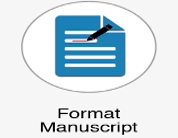In silico study of the interaction between serotonin and D7 protein from the salivary gland of Aedes aegypti
Abstract
Protein components of the salivary glands of disease vectors have been known to facilitate the blood-feeding process in the host body. The main component of the salivary glands of Aedes aegypti is the immunogenic D7 protein. During the blood-feeding process, the D7 protein can bind to biogenic amine compounds, such as serotonin, which is a neurotransmitter involved in platelet activation. This ability indicates that the D7 protein can inhibit the platelet aggregation process. This study aims to explore in silico the interaction between serotonin and the D7 protein from the salivary glands of Ae. aegypti using a molecular docking approach. The methods used in this study include the selection of the 3D structure of the D7 protein and serotonin ligand, preparation of the 3D structure of the D7 protein, native ligands, and test ligands, validation of the molecular docking method, and analysis and visualization of the molecular docking results. The results of molecular docking between the D7 protein and the serotonin ligand showed a ∆G value for the interaction of −9.25 kcal/mol. The serotonin ligand binds to the active site of the D7 protein through several amino acid residues, including GLU 158, ILE 175, ARG 176, TYR 178, TYR 248, ASP 265, and GLU 268. These amino acid residues of the D7 protein bind to atoms on the serotonin ligand through conventional hydrogen bonds, carbon hydrogen bonds, π-σ bonds, π-π T-shaped bonds, and π-alkyl bonds. Based on the in silico data, it is shown that the D7 protein from the salivary glands of Ae. aegypti can bind stably and spontaneously to serotonin ligands. This indicates that the D7 protein has potential as a platelet aggregation inhibitor agent for the development of drug discovery in the fields of health and pharmacy.
Keywords
Full Text:
View Full TextReferences
Wathon S, Mutiah F, Oktarianti R, Senjarini K. Purifikasi protein imunogenik 31 dan 56 kDa dari kelenjar saliva Aedes aegypti. Jurnal Bioteknologi dan Biosains Indonesia. 2020;7(1):59-71.
Wathon S, Oktarianti R, Senjarini K. Kelenjar saliva Aedes aegypti harapan baru pengembangan vaksin demam berdarah dengue. 2016.
Guerrero D, Cantaert T, Missé D. Aedes mosquito salivary components and their effect on the immune response to arboviruses. Frontiers in Cellular and Infection Microbiology. 2020;10:407.
Barros MS, Lara PG, Fonseca MT, Moretti EH, Filgueiras LR, Martins JO, et al. Aedes aegypti saliva impairs M1-associated proinflammatory phenotype without promoting or affecting M2 polarization of murine macrophages. Parasites & Vectors. 2019;12:1-15.
Gavor E, Choong YK, Liu Y, Pompon J, Ooi EE, Mok YK, et al. Identification of Aedes aegypti salivary gland proteins interacting with human immune receptor proteins. PLoS Neglected Tropical Diseases. 2022;16(9):e0010743.
Chowdhury A, Modahl CM, Missé D, Kini RM, Pompon J. High resolution proteomics of Aedes aegypti salivary glands infected with either dengue, Zika or chikungunya viruses identify new virus specific and broad antiviral factors. Scientific Reports. 2021;11(1):23696.
McCracken M, Christofferson R, Grasperge B, Calvo E, Chisenhall D, Mores C. Aedes aegypti salivary protein aegyptin co-inoculation modulates dengue virus infection in the vertebrate host. Virology. 2014;468:133-9.
Gulley MM, Zhang X, Michel K. The roles of serpins in mosquito immunology and physiology. Journal of insect physiology. 2013;59(2):138-47.
Alvarenga PH, Andersen JF. An overview of D7 protein structure and physiological roles in blood-feeding nematocera. Biology. 2022;12(1):39.
Martin-Martin I, Smith LB, Chagas AC, Sá-Nunes A, Shrivastava G, Valenzuela-Leon PC, et al. Aedes albopictus D7 salivary protein prevents host hemostasis and inflammation. Biomolecules. 2020;10(10):1372.
Michael ZM. Obat Penginduksi Pendarahan. Program Studi Apoteker, Fakultas Farmasi Universitas Padjadjaran. 2017.
Prasetiawati R, Suherman M, Permana B, Rahmawati R. Molecular docking study of anthocyanidin compounds against Epidermal Growth Factor Receptor (EGFR) as anti-lung cancer. Indonesian Journal of Pharmaceutical Science and Technology. 2021;8(1):8-20.
Wathon S, Oktarianti R, Senjarini K. Molecular Docking of Interaction between D7 Protein from the Salivary Gland of Aedes aegypti and Leukotriene A4 for Developing Thrombolytic Agent. In: BIO Web of Conferences. vol. 101. EDP Sciences; 2024. p. 04002.
Consortium U. UniProt: a worldwide hub of protein knowledge. Nucleic acids research. 2019;47(D1):D506-15.
Waterhouse A, Bertoni M, Bienert S, Studer G, Tauriello G, Gumienny R, et al. SWISS-MODEL: homology modelling of protein structures and complexes. Nucleic acids research. 2018;46(W1):W296-303.
Bienert S, Waterhouse A, De Beer TA, Tauriello G, Studer G, Bordoli L, et al. The SWISS-MODEL Repositorynew features and functionality. Nucleic acids research. 2017;45(D1):D313-9.
Wang Y, Bryant SH, Cheng T, Wang J, Gindulyte A, Shoemaker BA, et al. Pubchem bioassay: 2017 update. Nucleic acids research. 2017;45(D1):D955-63.
Morris GM, Huey R, Lindstrom W, Sanner MF, Belew RK, Goodsell DS, et al. AutoDock4 and AutoDockTools4: Automated docking with selective receptor flexibility. Journal of computational chemistry. 2009;30(16):2785-91.
Huey R, Morris GM, Forli S, et al. Using AutoDock 4 and AutoDock vina with AutoDockTools: a tutorial. The Scripps Research Institute Molecular Graphics Laboratory. 2012;10550(92037):1000.
Sari IW, Junaidin J, Pratiwi D. Studi Molecular Docking Senyawa Flavonoid Herba Kumis Kucing (Orthosiphon Stamineus B.) Pada Reseptor A-Glukosidase Sebagai Antidiabetes Tipe 2. Jurnal Farmagazine. 2020;7(2):54-60.
Sari IW, Junaidin J, Pratiwi D. Studi Molecular Docking Senyawa Flavonoid Herba Kumis Kucing (Orthosiphon Stamineus B.) Pada Reseptor A-Glukosidase Sebagai Antidiabetes Tipe 2. Jurnal Farmagazine. 2020;7(2):54-60.
Allinger NL. Conformational analysis. 130. MM2. A hydrocarbon force field utilizing V1 and V2 torsional terms. Journal of the American Chemical Society. 1977;99(25):8127-34.
Trott O, Olson AJ. AutoDock Vina: improving the speed and accuracy of docking with a new scoring function, efficient optimization, and multithreading. Journal of computational chemistry. 2010;31(2):455-61.
Endriyatno NC, Walid M. Studi In Silico Kandungan Senyawa Daun Srikaya (Annona squamosa L.) Terhadap Protein Dihydrofolate Reductase Pada Mycobacterium tuberculosis. Pharmacon: Jurnal Farmasi Indonesia. 2022;19(1):87-98.
Baroroh U, Biotek M, Muscifa ZS, Destiarani W, Rohmatullah FG, Yusuf M. Molecular interaction analysis and visualization of protein-ligand docking using Biovia Discovery Studio Visualizer. Indonesian Journal of Computational Biology (IJCB). 2023;2(1):22-30.
Wijaya H, Hasanah F. Prediction of Three-dimensional Structure From Food Allergen Protein Through Homology Method Using Swiss-model Program. Biopropal Industry. 2016;7(2):83-94.
Ahmed MZS. Homology Modeling and Structural Analysis of of the Flavanone 3-Hydroxylase (F3H) and Flavonoid 3-hydroxylase (F3H) Genes from Ginkgo Biloba (L.).
Biasini M, Bienert S, Waterhouse A, Arnold K, Studer G, Schmidt T, et al. SWISS-MODEL: modelling protein tertiary and quaternary structure using evolutionary information. Nucleic acids research. 2014;42(W1):W252-8.
Komari N, Hadi S, Suhartono E. Protein Modeling with Homology Modeling using SWISS-MODEL: Protein Modeling with Homology Modeling using SWISS-MODEL. Journal of Mathematics and Science Network. 2020;2(2):65-70.
Kanduc D. Homology, similarity, and identity in peptide epitope immunodefinition. Journal of Peptide Science. 2012;18(8):487-94.
Wu F, Liang T, Xiao W, Wang T. Norepinephrine in goal-directed fluid therapy during general anesthesia in elderly patients undergoing spinal operation: determining effective infusion rate to enhance postoperative functions. Current Genomics. 2021;22(8):620-9.
Angles R, Arenas-Salinas M, García R, Ingram B. An optimized relational database for querying structural patterns in proteins. Database. 2024;2024:baad093.
Aziz A, Andrianto D, Safithri M. Penambatan Molekuler Senyawa Bioaktif Daun Wungu (Graptophyllum Pictum (L) Griff) sebagai Inhibitor Tirosinase. Indonesian Journal of Pharmaceutical Science and Technology. 2022;9(2):96-107.
Marcinkowska M, Kubacka M, Zagorska A, Jaromin A, Fajkis Zajaczkowska N, Kolaczkowski M. Exploring the antiplatelet activity of serotonin 5-HT2A receptor antagonists bearing 6-fluorobenzo [d] isoxazol-3-yl) propyl) motif–as potential therapeutic agents in the prevention of cardiovascular diseases. Biomedicine & Pharmacotherapy. 2022;145:112424.
Yang D, Gouaux E. Illumination of serotonin transporter mechanism and role of the allosteric site. Science Advances. 2021;7(49):eabl3857.
Kim S, Chen J, Cheng T, Gindulyte A, He J, He S, et al. PubChem 2023 update. Nucleic acids research. 2023;51(D1):D1373-80.
Attique SA, Hassan M, Usman M, Atif RM, Mahboob S, Al-Ghanim KA, et al. A molecular docking approach to evaluate the pharmacological properties of natural and synthetic treatment candidates for use against hypertension. International journal of environmental research and public health. 2019;16(6):923.
Ferencz L, Muntean DL. Identification of new superwarfarin-type rodenticides by structural similarity. The docking of ligands on the vitamin K epoxide reductase enzymes active site. Acta Universitatis Sapientiae, Agriculture and Environment. 2015;7(1):108-22.
Morris GM, Goodsell DS, Pique ME, Huey R, Hart WE, Halliday S, et al.. AutoDock Version 4.2: Updated for version 4.2.6. Automated Docking of Flexible Ligands to Flexible Receptors; 2014. The Scripps Research Institute, La Jolla, CA, USA.
Khan T, Lawrence AJ, Azad I, Raza S, Khan AR. Molecular Docking Simulation with Special Reference to Flexible Docking Approach. JSM Chemistry. 2018;6(1):1-5.
Jiménez JS, Benítez MJ. Gibbs Free Energy and Enthalpy–Entropy Compensation in Protein–Ligand Interactions. Biophysica. 2024;4(2):298-309.
Choma CT. Characterizing Binding Interactions by ITC; 2006. Document No. 10111020706.
Forouzesh N, Mishra N. An Effective MM/GBSA Protocol for Absolute Binding Free Energy Calculations: A Case Study on SARS-CoV-2 Spike Protein and the Human ACE2 Receptor. Molecules. 2021;26(8):2383.
Du X, Li Y, Xia YL, Ai SM, Liang J, Sang P, et al. Insights into Protein–Ligand Interactions: Mechanisms, Models, and Methods. International Journal of Molecular Sciences. 2016;17(2):144.
Mishra KK, Borish K, Singh G, Panwaria P, Metya S, Madhusudhan MS, et al. Observation of an Unusually Large IR Red-Shift in an Unconventional S–H·S Hydrogen-Bond. Journal of Physical Chemistry Letters. 2021;12(4):1228-35.
Zierkiewicz W, Michalczyk M, Scheiner S. Noncovalent Bonds through Sigma and Pi-Hole Located on the Same Molecule. Guiding Principles and Comparisons. Molecules. 2021;26(6):1740.
Alencar WLM, da Silva Arouche T, Neto AFG, de Castro Ramalho T, de Carvalho Júnior RN, de Jesus Chaves Neto AM. Interactions of Co, Cu, and Non-metal Phthalocyanines with External Structures of SARS-CoV-2 Using Docking and Molecular Dynamics. Scientific Reports. 2022;12(1):3316.
DOI: https://doi.org/10.36462/H.BioSci.202501
Refbacks
- There are currently no refbacks.
Copyright (c) 2025 Oktarianti R et al.

This work is licensed under a Creative Commons Attribution 4.0 International License.
...........................................................................................................................................................
Other "Highlights in" Journals
Highlights in Bioinformatics, Highlights in Chemistry, Highlights in Science, Highlights in Microbiology, Highlights in Plant Science
........................................................................................................................................
International Library of Science "HighlightsIn" is an Open Access Scientific Publishers, aiming to science and knowledge support













